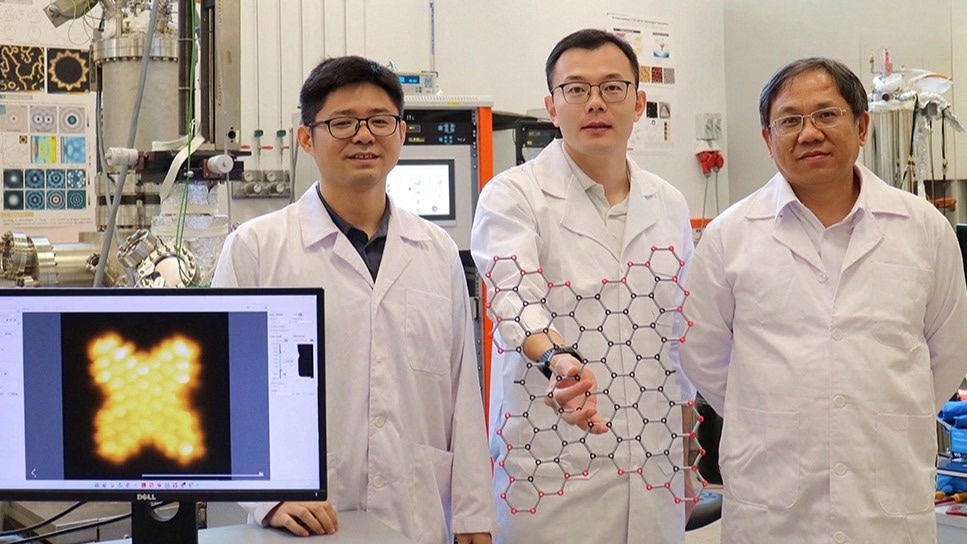Reviewed by Lexie CornerApr 15 2024
Researchers at the National University of Singapore (NUS) have created a novel design idea for next-generation carbon-based quantum materials in the form of a small magnetic nanographene with a distinct butterfly shape that houses strongly correlated spins.
 NUS researchers Assoc Prof Lu Jiong (left), Dr. Song Shaotang (centre), and Prof Wu Jishan (right) were part of the multidisciplinary research team which developed the butterfly-shaped magnetic nanographene which could advance quantum technologies. Image Credit: National University of Singapore
NUS researchers Assoc Prof Lu Jiong (left), Dr. Song Shaotang (centre), and Prof Wu Jishan (right) were part of the multidisciplinary research team which developed the butterfly-shaped magnetic nanographene which could advance quantum technologies. Image Credit: National University of Singapore
This innovative design has the potential to expedite the growth of quantum materials, which are critical for the development of advanced quantum computing technologies that will revolutionize information processing and high-density storage capacities.
Associate Professor Lu Jiong of the NUS Department of Chemistry and Institute for Functional Intelligent Materials headed the project, which also included Professor Wu Jishan from the NUS Department of Chemistry and international collaborators.
Magnetic nanographene, a nanostructure comprised of graphene molecules, has exceptional magnetic capabilities due to the behavior of particular electrons in the carbon atoms’ π-orbitals. These unique electrons can be controlled by precisely arranging these carbon atoms at the nanoscale.
This makes nanographene particularly promising for producing incredibly small magnets and the essential building pieces required for quantum computers, known as quantum bits or qubits.
The researchers’ butterfly-shaped magnetic graphene features four rounded triangles that resemble butterfly wings. Each wing has an unpaired π-electron responsible for the discovered magnetic characteristics. The structure was created using an atomic-precise design of the π-electron network in nanostructured graphene.
Magnetic nanographene, a tiny molecule composed of fused benzene rings, holds significant promise as a next-generation quantum material for hosting fascinating quantum spins due to its chemical versatility and long spin coherence time. However, creating multiple highly entangled spins in such systems is a daunting yet essential task for building scalable and complex quantum networks.
Lu Jiong, Associate Professor, Department of Chemistry, National University of Singapore
The remarkable breakthrough is the result of close collaboration involving synthetic chemists, materials scientists, and physicists, including key contributors Professor Pavel Jelinek and Dr. Libor Vei of the Czech Academy of Sciences in Prague.
On February 19th, 2024, Nature Chemistry published this groundbreaking study.
A New-Generation Magnetic Nanographene with Highly Entangled Spins
The magnetic characteristics of nanographene are often determined by the configuration of its unique electrons, known as π-electrons, or the strength of their interactions. However, combining these features to generate numerous associated spins is difficult. Nanographene also has a unique magnetic order, with spins aligning in either the same direction (ferromagnetic) or opposing directions (antiferromagnetic).
The researchers devised a strategy to circumvent these obstacles. Their butterfly-shaped nanographene, which has ferromagnetic and antiferromagnetic characteristics, is created by merging four smaller triangles into a rhombus in the center. Nanographene is roughly 3 nanometers in size.
To make the “butterfly” nanographene, the researchers first created a unique molecule precursor using traditional in-solution chemistry. This precursor was then employed for the on-surface synthesis, a novel type of solid-phase chemical reaction carried out in a vacuum environment. This method enabled the researchers to accurately manipulate the form and structure of nanographene at the atomic level.
The “butterfly” nanographene has four unpaired π-electrons, with spins delocalized in the “wing” regions and entangled together. The researchers used an ultra-cold scanning probe microscope with a nickelocene tip as an atomic-scale spin sensor to test the magnetism of butterfly nanographenes.
This novel technology also allows scientists to probe entangled spins directly to better understand how nanographene’s magnetism operates at the atomic level. The innovation not only addresses current obstacles but also offers up new avenues for accurately manipulating magnetic characteristics at the smallest scale, resulting in promising advances in quantum materials research.
Lu added, “The insights gained from this study pave the way for creating new-generation organic quantum materials with designer quantum spin architectures. Looking ahead, our goal is to measure the spin dynamics and coherence time at the single-molecule level and manipulate these entangled spins coherently. This represents a significant stride towards achieving more powerful information processing and storage capabilities.”
Journal Reference:
Song, S., et al. (2024) Highly entangled polyradical nanographene with coexisting strong correlation and topological frustration. Nature Chemistry. doi:10.1038/s41557-024-01453-9